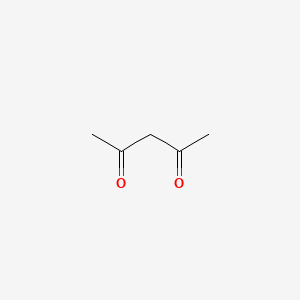| MeSH term | MeSH ID | Detail |
|---|---|---|
| Adenocarcinoma | D000230 | 166 associated lipids |
| Body Weight | D001835 | 333 associated lipids |
| Dermatitis, Contact | D003877 | 59 associated lipids |
| Eczema | D004485 | 4 associated lipids |
| Edema | D004487 | 152 associated lipids |
| Fetal Resorption | D005327 | 15 associated lipids |
| Glioma | D005910 | 112 associated lipids |
| Nervous System Diseases | D009422 | 37 associated lipids |
| Purpura, Thrombocytopenic | D011696 | 2 associated lipids |
| Seizures | D012640 | 87 associated lipids |
2,4-pentanedione
2,4-pentanedione is a lipid of Fatty Acyls (FA) class. The related lipids are Butyrates.
Cross Reference
Introduction
To understand associated biological information of 2,4-pentanedione, we collected biological information of abnormalities, associated pathways, cellular/molecular locations, biological functions, related genes/proteins, lipids and common seen animal/experimental models with organized paragraphs from literatures.
What diseases are associated with 2,4-pentanedione?
There are no associated biomedical information in the current reference collection.
Possible diseases from mapped MeSH terms on references
We collected disease MeSH terms mapped to the references associated with 2,4-pentanedione
PubChem Associated disorders and diseases
What pathways are associated with 2,4-pentanedione
There are no associated biomedical information in the current reference collection.
PubChem Biomolecular Interactions and Pathways
Link to PubChem Biomolecular Interactions and PathwaysWhat cellular locations are associated with 2,4-pentanedione?
There are no associated biomedical information in the current reference collection.
What functions are associated with 2,4-pentanedione?
There are no associated biomedical information in the current reference collection.
What lipids are associated with 2,4-pentanedione?
Related references are published most in these journals:
| Lipid concept | Cross reference | Weighted score | Related literatures |
|---|
What genes are associated with 2,4-pentanedione?
There are no associated biomedical information in the current reference collection.
What common seen animal models are associated with 2,4-pentanedione?
There are no associated biomedical information in the current reference collection.
NCBI Entrez Crosslinks
All references with 2,4-pentanedione
Download all related citations| Authors | Title | Published | Journal | PubMed Link |
|---|---|---|---|---|
| Kong LA et al. | Different chitin synthase genes are required for various developmental and plant infection processes in the rice blast fungus Magnaporthe oryzae. | 2012 | PLoS Pathog. | pmid:22346755 |
| Devi PS et al. | DNA Damage Protecting Activity and Free Radical Scavenging Activity of Anthocyanins from Red Sorghum (Sorghum bicolor) Bran. | 2012 | Biotechnol Res Int | pmid:22400119 |
| Al-Amiery AA et al. | Antifungal and antioxidant activities of pyrrolidone thiosemicarbazone complexes. | 2012 | Bioinorg Chem Appl | pmid:22400016 |
| Kawamoto K and Shibahara T | Trichlorido{2-dimeth-oxy-methyl-4-methyl-6-[(quinolin-8-yl)imino-meth-yl]phenolato-κN,N',O}tin(IV). | 2012 | Acta Crystallogr Sect E Struct Rep Online | pmid:22346872 |
| Chen PY et al. | Sensitive and simple flow injection analysis of formaldehyde using an activated barrel plating nickel electrode. | 2011 Sep-Oct | J AOAC Int | pmid:22165025 |
| Nofal ZM et al. | Synthesis of new pyrimidine derivatives with evaluation of their anti-inflammatory and analgesic activities. | 2011 Jul-Aug | Acta Pol Pharm | pmid:21796933 |
| Pilalis E et al. | Escherichia coli genome-wide promoter analysis: identification of additional AtoC binding target elements. | 2011 | BMC Genomics | pmid:21569465 |
| Bernocchi G et al. | Developing central nervous system and vulnerability to platinum compounds. | 2011 | Chemother Res Pract | pmid:22312552 |
| Ovcharenko VI et al. | "Jumping crystals": oxygen-evolving metal-nitroxide complexes. | 2011 | Inorg Chem | pmid:21491890 |
| LoPachin RM et al. | β-dicarbonyl enolates: a new class of neuroprotectants. | 2011 | J. Neurochem. | pmid:21054388 |
